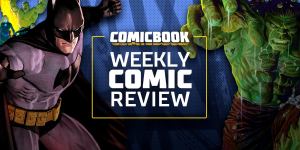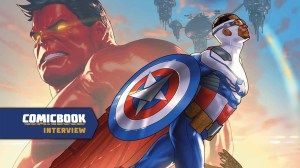
This is a bittersweet commentary for me to put together, since I’m covering John Carter: Warlord of Mars #14, the final issue of the current series. As I’ve said before, this is a series, and a set of characters, that I’ve wanted to write since I first discovered the original Edgar Rice Burroughs Mars series when I was a kid. I’m disappointed that we’ve come to the end of the run, but I’ve loved every minute of this job.
Videos by ComicBook.com
You can visit your local comic shop, or pick up a digital copy of the issue here to read along.

PAGE 1
It’s not unusual for me to open an issue with some kind of cinematic sequence, something to draw the reader into the story. In this case, the story literally comes to the reader as John Carter and Dejah Thoris draw near in their flyer over a series of panels.

PAGES 2-3
This is probably not the kind of double-page spread that artists dream about: “Draw a whole city!” But I felt like we needed a shot to convey the scope — and emptiness — of Helium, which is deserted in this story. Artist Ariel Medel admirably rose to the challenge of a thankless task and provided the lines, with Nanjan Jamberi adding the color. This spread contains a huge amount of work, created over painstaking hours. I hope readers spend some time poring over and appreciating the artwork here.

PAGE 5
The four panels here are intended to give the reader a sense that John and Dejah explore various areas of Helium, finding all of them deserted. In the script I requested four horizontal panels, each the same size, so the visuals have an even, measured rhythm to them. No panel is given more or less importance than another, each is a snapshot of a different place and moment. Ariel did a nice job of varying angles, and using John and Dejah’s figures to move to reader’s eye around the page.
PAGE 6
Drawing monthly comics is a brutal grind, especially if you’re penciling and then inking yourself. Ariel Medel nailed every deadline since he took over the series with issue #7, eight issues in a row without a fill-in. That’s a hell of an accomplishment, especially for someone working on his first U.S. series, especially when each issue is 22 pages, rather than the now-standard 20 pages. Obviously, Ariel has a tremendous work ethic. He’s also very smart about utilizing shortcuts where he can.
This page is a great example of choosing wisely to save time and stay ahead of deadline doom as it rockets down the tracks. Panel 1 features a long shot and small figures, relatively quick to draw once the perspective is figured out. Dropping the background in panel 2 saves time, and also serves to really pop the figures of John and Dejah. Panel 3 doesn’t waste effort on background that was going to be covered by balloons anyway. Panels 4 and 5 crop John and Dejah’s figures effectively, both heightening the intensity of the scene, and making for less to draw. All together, it’s a visually appealing page, as well as a smart one.
PAGE 10
You’ll often see comic pages that contain figures of relatively the same size in most if not all of the panels. Pull out a comic, flip to random page. Are most of the heads on that page about the size of your thumb print? If so, the artist — and by extension, the writer — constructed the page poorly (unless there’s a specific cinematic effect at play). Comics are visual documents. A page should be visually enticing to the reader, and one way to do that is varying angles and figure sizes. There’s some great acting on this page as John and Dejah come to grips with what’s happened to them. The choice of extreme close-ups in panels 3 and 4 really lends variety to the page. And I adore the shot of John and Dejah with their foreheads touching in panel 5.
PAGES 12 & 13
These two pages cut back and forth between tight shots and long shots, panel for panel. I love the beat-for-beat rhythms that comics offers creators. Here we alternate between scope and human drama, until they come together in a literally explosive moment.
PAGE 14
The story changes abruptly here, and so does the color palette. Nanjan brings a darker sensibility to this sequence, subtly communicating that the story has taken an drastic turn. We start the page with a close-up of John, inviting the reader to experience the shocking transition as John does, then pulling back in panel 2 to reveal more of the surroundings.
PAGE 19
When Ian and I kicked around the idea of revealing John and Dejah had been trapped in an evil mastermind’s dream world, I wanted to leave open to the reader’s interpretation exactly what was real and what wasn’t. I like stories that don’t provide pat answers, and leave something for the audience to ponder. That’s the intent here; you’re free to decide how much or how little was “real.”
PAGE 22
We come to the end, with John, Dejah, Tars Tarkas, Kantos Kan, and of course Woola turning to face the future. There are always more stories to tell. I hope I get the chance someday.
There’s a long list of people who deserve Barsoomian thanks: my co-writer Ian Edginton; artists Abhishek Malsuni, Ariel Medel, Zsolt Garisa, Nanjan Jamberi and Roberto Castro; the many cover artists who have graced the series; my editor, Joe Rybandt; and Dynamite publisher Nick Barrucci. I have been dreaming of Mars since I was a boy, and all of you helped that dream come true.



